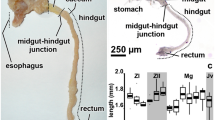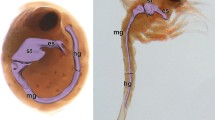Abstract
The study of the microscopic anatomy of the larvae of Entoprocta is interesting in the context of determining the phylogenetic position of this group. It is assumed that the comparison of the organization of larval stages of entoprocts with different life cycle stages of other taxa (bryozoans, cycliophorans, mollusks) may help to find common features in their organization, indicating possible close relationships of these groups. There are few data on the microscopic anatomy of the larvae of entoprocts. The fine structure of larvae of only two solitary species, Loxosomella murmanica and Loxosoma pectinaricola, has been described in detail. Here we described the ultrastructure of the swimming larva of colonial species Barentsia gracilis. Our data clarify some details of the structure of entoproct larvae. The cuticle of larval stages is similar to that of adults. The prototroch is represented by two rows of ciliated cells. The apical and frontal ganglia are devoid of a central neuropil, which distinguishes them from the ganglion of adults. Ganglia include not only nerve cells but also muscle cells. The digestive tract of larvae and adults is similar not only at the histological level but also at the ultrastructural level. Three pairs of pedal glands include cells with electron-dense granules and cells with vacuoles with granular contents. These glands probably secrete different components of mucus. Each of the protonephridia consists of two terminal cells that pass into their own canals, which then fuse together and open by the nephropore on the hyposphere.











Similar content being viewed by others
Data availability
The data that support the findings of this study are available from the corresponding author, Borisanova A.O., upon request.
References
Becker G (1937) Untersuchungen über den Darm und die Verdauung von Kamptozoen, Bryozoen und Phoroniden. Zoomorphology 33:72–127. https://doi.org/10.1007/BF00407482
Borisanova AO, Chernyshev AV, Malakhov VV (2012) The structure of the muscular system in the planktonic larva of colonial Kamptozoa. Dokl Biol Sci 442:31–33. https://doi.org/10.1134/S0012496612010097
Borisanova AO, Yushin VV, Malakhov VV, Temereva EN (2015) The fine structure of the cuticle of kamptozoans is similar to that of annelids. Zoomorphology 134:165–181. https://doi.org/10.1007/s00435-015-0261-z
Borisanova AO, Malakhov VV, Temereva EN (2019) The neuroanatomy of Barentsia discreta (Entoprocta, Coloniales) reveals significant differences between bryozoan and entoproct nervous systems. Front Zool 16:1–15. https://doi.org/10.1186/s12983-019-0307-z
Borisanova AO (2018) Entoprocta (Kamptozoa). In: Schmidt-Rhaesa A (ed) Handbook of Zoology. Miscellaneous Invertebrates, De Gruyter, Berlin, pp 111–162
Chia FS, Koss R (1984) Fine structure of the cephalic sensory organ in the larva of the nudibranch Rostanga pulchra (Mollusca, Opisthobranchia, Nudibranchia). Zoomorphology 104(3):131–139. https://doi.org/10.1007/BF00312131
Czwiklitzer R (1909) Die Anatomie der Larve von Pedicellina echinata. Arb Zool Inst Univ Wien 17:157–186
Dittmann IL, Grosbusch AL, Nagler M, Salvenmoser W, Zankel A, Telford MJ, Egger B (2023) The ultrastructure of the apical organ of the Müller’s larva of the tiger flatworm Prostheceraeus crozieri. Cell Biol Int 47(8):1354–1367. https://doi.org/10.1002/cbin.12023
Franke M (1993) Ultrastructure of the protonephridia in Loxosomella fauveli, Barentsia matsushimana and Pedicellina cernua. implications for the protonephridia in the ground pattern of the Entoprocta (Kamptozoa). Microfauna 8:7–38
Fuchs J, Wanninger A (2008) Reconstruction of the neuromuscular system of the swimming-type larva of Loxosomella atkinsae (Entoprocta) as inferred by fluorescence labelling and confocal microscopy. Org Divers Evol 8:325–335. https://doi.org/10.1016/j.ode.2008.05.002
Haszprunar G (1986) Feinmorphologische Untersuchungen an Sinnesstrukturen ursprünglicher Solenogastres (Mollusca). Zool Anz 217(5-6):345-362.
Haszprunar G (1987) The fine morphology of the osphradial sense organs of the mollusca. III. Placophora and Bivalvia. Phil Trans R Soc Lond B 315:37–61. https://doi.org/10.1098/rstb.1987.0002
Haszprunar G, Wanninger A (2008) On the fine structure of the creeping larva of Loxosomella murmanica: additional evidence for a clade of Kamptozoa (Entoprocta) and Mollusca. Acta Zool 89:137–148. https://doi.org/10.1111/j.1463-6395.2007.00301.x
Ivanova-Kazas OM (1986) The origin and phylogenetic significance of the trochophore larvae. 4. Larvae of Kamptozoa. General Ideas Zool Zh 65:165–174 ((in Russian))
Jägersten G (1964) On the morphology and reproduction of entoproct larvae. Zoologiska Bidrag Uppsala 36:295–314
Jägersten G (1972) Evolution of the metazoan life cycle: a comprehensive theory. Academic Press
Kümmel G (1962) Zwei neue Formen von Cyrtocyten. Vergleich der bisher bekannten Cyrtocyten und Erörterung des Begriffes „Zelltyp“. Z Zellforsch Mik Ana 57:172–201. https://doi.org/10.1007/BF00319392
Malakhov VV (1990) Description of the development of Ascopodaria discreta (Coloniales, Barentsiidae) and discussion of the Kamptozoa status in the animal kingdom. Zool Zh 69:20–30 ((in Russian))
Marcus E (1939) Bryozoarios Marinhos Brasileiros III. Bol Fac Fil Cien Letr Univ Sao Paulo, Zool 3:111–353
Mariscal RN (1965) The adult and larval morphology and life history of the Entoproct Barentsia gracilis (M. Sars, 1835). J Morphol 116:311–338. https://doi.org/10.1002/jmor.1051160302
Mastrodonato M, Lepore E, Gherardi M, Zizza S, Sciscioli M, Ferri D (2005) Histochemical and ultrastructural analysis of the epidermal gland cells of Branchiomma luctuosum (Polychaeta, Sabellidae). Invertebr Biol 124(4):303–309. https://doi.org/10.1111/j.1744-7410.2005.00028.x
Mastrodonato M, Gherardi M, Todisco G, Sciscioli M, Lepore E (2006) The epidermis of Timarete filigera (Polychaeta, Cirratulidae): histochemical and ultrastructural analysis of the gland cells. Tissue Cell 38(5):279–284. https://doi.org/10.1016/j.tice.2006.06.003
Merkel J, Lieb B, Wanninger A (2015) Muscular anatomy of an entoproct creeping-type larva reveals extraordinary high complexity and potential shared characters with mollusks. BMC Evol Biol 15:130. https://doi.org/10.1186/s12862-015-0394-1
Nielsen C (1966) On the life-cycle of some Loxosomatidae (Entoprocta). Ophelia 3:221–247. https://doi.org/10.1080/00785326.1966.10409644
Nielsen C (1967) Metamorphosis of the larva of Loxosomella murmanica (Nilus) (Entoprocta). Ophelia 4(1):85–89. https://doi.org/10.1080/00785326.1967.10409613
Nielsen C (1971) Entoproct life-cycles and the Entoproct/Ectoproct relationship. Ophelia 9:209–341. https://doi.org/10.1080/00785326.1971.10430095
Nielsen C (1989) Entoprocts: Keys and notes for the identification of the species. Synop Br Fauna new ser 41:1–131.
Nielsen C (2002) Phylum Entoprocta. In: Young CM, Sewell MA, Rice ME (eds) Atlas of Marine Invertebrate Larvae. Academic Press, San Diego, pp 397–409
Obst M, Funch P (2003) Dwarf male of Symbion pandora (Cycliophora). J Morphol 255:261–278. https://doi.org/10.1002/jmor.10040
Pinchuck SC, Hodgson AN (2009) Comparative structure of the lateral pedal defensive glands of three species of Siphonaria (Gastropoda: Basommatophora). J Molluscan Stud 75(4):371–380. https://doi.org/10.1093/mollus/eyp034
Sensenbaugh T (1987) Ultrastructural observations on the larva of Loxosoma pectinaricola Franzén (Entoprocta, Loxosomatidae). Acta Zool 68:135–145. https://doi.org/10.1111/j.1463-6395.1987.tb00884.x
Wanninger A, Fuchs J, Haszprunar G (2007) Anatomy of the serotonergic nervous system of an entoproct creeping-type larva and its phylogenetic implications. Invertebr Biol 126:268–278. https://doi.org/10.1111/j.1744-7410.2007.00097.x
Yang H, Hochberg R, Walsh EJ, Wallace RL (2021) Ultrastructure of extracorporeal secretions of four sessile species of Rotifera (Gnesiotrocha), with observations on the chemistry of the gelatinous tube. Invertebr Biol 140(2):e12318. https://doi.org/10.1111/ivb.12318
Acknowledgements
The authors are grateful to the management of Pertsov White Sea Biological Station of Lomonosov Moscow State University (WSBS MSU) and the center of microscopy of WSBS for opportunity to conduct the research and especially to WSBS diving team for their assistance in samples collecting. SEM studies and TEM studies were carried out at the Shared Research Facility “Electron Microscopy in Life Sciences” at Moscow State University (Unique Equipment “Three-dimensional electron microscopy and spectroscopy”). The authors are thankfull to the Reviewers for their thoughtful comments.
Funding
This work was supported by the Russian Science Foundation (Grant number 23-14-00020).
Author information
Authors and Affiliations
Contributions
O.I. collected and fixed the material. Both authors participated in the preparation of the material for research by transmission electron microscopy and in obtaining the results. A.B. wrote the main manuscript text and prepared all figures.
Corresponding author
Ethics declarations
Conflict of interest
The authors have no competing interests to declare that are relevant to the content of this article.
Additional information
Publisher's Note
Springer Nature remains neutral with regard to jurisdictional claims in published maps and institutional affiliations.
Rights and permissions
Springer Nature or its licensor (e.g. a society or other partner) holds exclusive rights to this article under a publishing agreement with the author(s) or other rightsholder(s); author self-archiving of the accepted manuscript version of this article is solely governed by the terms of such publishing agreement and applicable law.
About this article
Cite this article
Borisanova, A.O., Ivanova, O.V. Ultrastructure of a swimming-type larva of Barentsia gracilis (Entoprocta, Coloniales). Zoomorphology (2024). https://doi.org/10.1007/s00435-024-00657-4
Received:
Revised:
Accepted:
Published:
DOI: https://doi.org/10.1007/s00435-024-00657-4




